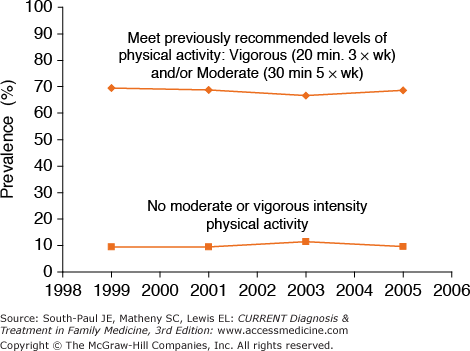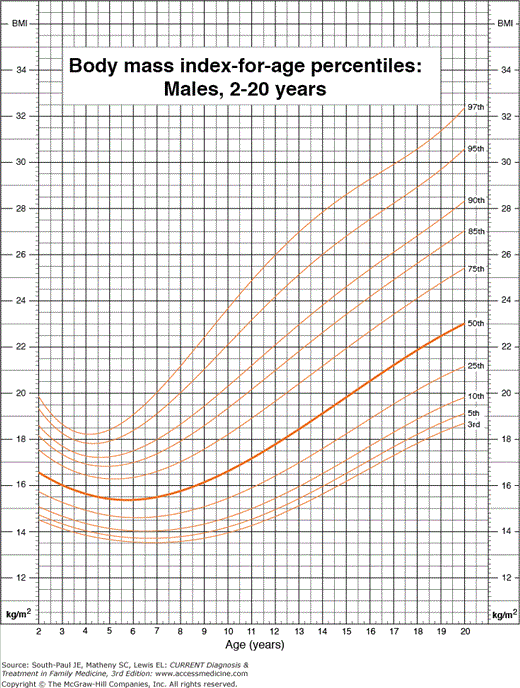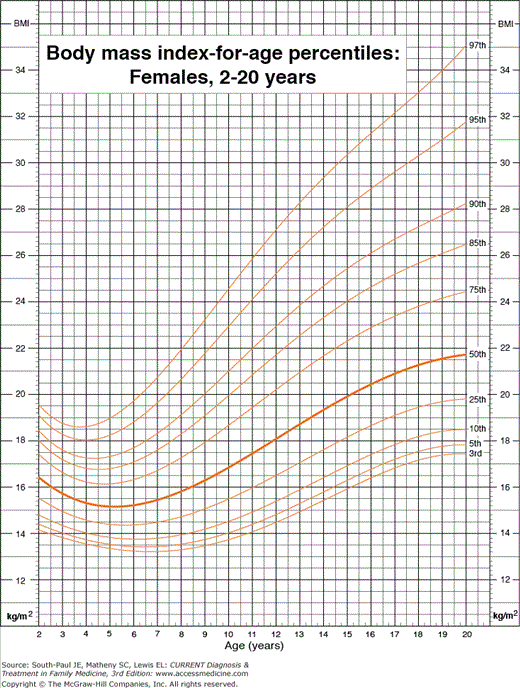Physical Activity in Adolescents: Introduction
The United States continues to battle an epidemic of physical inactivity and obesity. Over the past three decades, declines in physical inactivity have mirrored the rise in obesity among children and adolescents. Longitudinal data from the National Health and Examination Surveys show that over the past 30 years the percentage of overweight and obese adolescents in the United States has increased from 5% to over 17%. Obese youth are less likely to engage in physical activity and are much more likely to report chronic health problems compared with peers of normal weight. Obese adolescents are also more likely to be obese as adults.
During adolescence, levels of spontaneous physical activity drop significantly from childhood levels. The number of US adolescents meeting recommended activity levels is low, and this figure has not changed significantly over the past 10 years (Figure 10-1). Adolescents spend much of their time engaged in sedentary activities. Most adolescents engage in at least 1 hour of technology-related behavior (television viewing, Internet surfing, gaming device) per day. In contrast, adolescents currently average a mere 12 min/d of vigorous physical activity. One-third of US high-school students are not regularly active; one-half of high school seniors are not enrolled in physical education classes, and 70% of all high school students watch at least 1 hour of television every day of the week. For those students enrolled in physical education, the actual amount of class time devoted to physical activity has dropped significantly over the past decade. Students spend a majority of time in physical education class standing around, waiting for instructions, or socializing. Teens who are active in school sporting activities are more likely to be active as adults. The bottom line is that behaviors that are initiated in childhood tend to consolidate during adolescence. Therefore, health-related behaviors, such as dietary habits and physical activity patterns, solidify during adolescence and persist into adulthood. Recognition of individuals who are insufficiently active, overweight, or obese during adolescence is important.
Chapter disclaimer: The opinions herein are those of the author. They do not represent official policy of the Department of Defense, the Department of the Navy, or the Uniformed Services University.
Definitions
The following definitions apply to the discussion of physical activity and obesity (Table 10-1). Physical fitness refers to a general state of well-being that allows an individual to perform activities of daily living in a vigorous manner. Physical fitness is further described in terms of health-related characteristics and skill-related characteristics. Health-related components of physical fitness include cardiorespiratory endurance, muscular strength, muscular endurance, flexibility, and body composition. Skill-related components of physical fitness include power, speed, agility, and balance. Historically, physical education programs have focused on skill-related activities and athletic ability. From a public health perspective, however, the health-related components of physical fitness are more important in terms of overall morbidity and mortality from chronic diseases related to physical inactivity.
| Physical activity | Any bodily movement that results in the expenditureof energy |
| Physicalfitness | A general state of overall well-being that allows individuals to conduct the majority of their activities of daily living in a vigorous manner |
| Health-related physical fitness | Aerobic capacity (cardiorespiratory endurance) |
| Body composition | |
| Muscular strength | |
| Muscular endurance | |
| Flexibility | |
| Skill-related physical fitness | Power |
| Agility | |
| Speed | |
| Balance | |
| Coordination | |
| Reaction time | |
| Exercise | A structured routine of physical activity specifically designed to improve or maintain one of the components of health-related physical fitness |
Physical activity refers to any bodily movement resulting in the expenditure of energy. Physical activity occurs in a broad range of settings. Leisure-time activities, occupational activities, routine activities of daily living, and dedicated exercise sessions are all valid forms of physical activity. Physical activity varies along a continuum of intensity from light (eg, housework) to moderate (eg, jogging) to more vigorous (eg, strenuous bicycling). Exercise is a structured routine of physical activity specifically designed to improve or maintain one of the components of health-related physical fitness. Historically, society has placed more emphasis on formal exercise programs as the primary means of achieving physical fitness rather than promoting physical activity in a more general sense.
Body mass index (BMI) is the anthropometric measurement of choice for assessing body composition in children, adolescents, and adults. BMI is calculated by dividing an individual’s weight (in kilograms) by the square of the individual’s height (in meters). Charts and digital tools for the office (http://www.cdc.gov/nccdphp/dnpa/bmi/calc-bmi.htm) and for handheld computers () are available for rapid calculation of BMI. Normative values for underweight, normal weight, overweight, and obesity for adolescents have been established, and are presented in Table 10-2. BMI-for-age charts have replaced standard weight-for-height charts as the preferred mechanism for tracking weight in children and adolescents (Figures 10-2 and 10-3). Overweight adolescents are those who fall between the 85th and 95th percentile of BMI-for-age. Obese adolescents are above the 95th percentile of weight-for-age.
| Definition | Clinical Parameter |
|---|---|
| Obesity (adults) | BMI >30 |
| Overweight (adults) | BMI 25.1-29.9 |
| Obesity (adolescents) | BMI >95th percentile for age |
| Overweight (adolescents) | 95th < BMI >85th percentile for age |
| Underweight (adolescents) | BMI <5th percentile for age |
Risks Associated with Physical Inactivity
Physical inactivity is a primary risk factor for cardiovascular disease and all-cause mortality. A sedentary lifestyle also contributes to increased rates of diabetes, hypertension, hyperlipidemia, osteoporosis, cerebrovascular disease, and colon cancer. Adolescents who are less physically active are more likely to smoke cigarettes, less likely to consume appropriate amounts of fruits and vegetables, less likely to routinely wear a seat belt, and more likely to spend increased time engaged in sedentary technology-related behaviors.
Physical activity serves numerous preventive functions. In addition to preventing chronic diseases such as hypertension, diabetes, and cardiovascular disease, sufficient levels of physical activity on a regular basis are associated with lower rates of mental illness. Teens who spend more time engaged in sedentary technology-related behaviors have higher rates of depression. Physically active adolescents have lower levels of stress and anxiety and have higher self-esteem than sedentary peers. Active adolescents also have fewer somatic complaints, and are more confident about their own future health. They have improved relationships with parents and authority figures, and also have a better body image.
Factors Influencing Physical Activity
Despite the overwhelming evidence supporting the health-related benefits of physical activity, young Americans are increasingly sedentary. A complex interaction of social, cultural, gender-based, environmental, and familial factors associated with “modern living” has contributed to decreased rates of physical activity.
Socioeconomic status is one of the strongest predictors of physical activity in both adolescents and adults. Lower socioeconomic status is associated with lower levels of spontaneous physical activity. Youth of higher socioeconomic status engage in more spontaneous physical activity, are more frequently enrolled in physical education classes, and are more active during physical education classes compared with peers of lower socioeconomic status. This relationship persists when controlling for age, gender, and ethnicity. The Task Force on Community Preventive Services (www.thecommunityguide.org), found strong evidence of the effectiveness of implementing programs which increase the length or activity levels of school-based physical education classes, improving both physical activity levels and physical fitness in school-aged children and adolescents.
Stay updated, free articles. Join our Telegram channel

Full access? Get Clinical Tree





